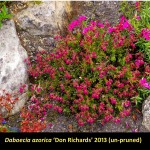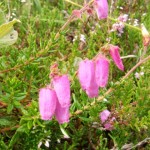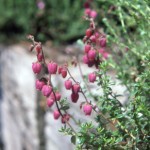St Dabeoc's heathDaboecia
Cultivar lists can be found highlighted in bold throughout the text for each species.
Daboecia azorica : Queiró, Azores heath

Dwarf shrub, to 20cm (8in) tall, spreading to 40cm (16in), distinguished from Daboecia cantabrica by the smaller leaves and the lack of hairs on the ruby (very rarely pink or white) flowers. Suitable for USDA zone 8.
When regarded as a subspecies of Daboecia cantabrica its name is Daboecia cantabrica subsp. azorica.
In the Azores, this heath grows in very well drained volcanic gravels, so it does best when provided with similar conditions in gardens. However, it is most uncommon and difficult to obtain, and only one cultivar has been distinguished and named.
Daboecia cantabrica : St Dabeoc’s heath, Irish heath

Sprawling or compact shrub, to 40cm (16in) tall, spreading to 70cm (28in); leaves glossy, dark green 1.5cm (2/3in) long, 6mm (¼in) wide; flowers about 1cm (3/8in) long, usually lavender, summer to autumn. Suitable for USDA zone 6 with protection but some winter damage can occur if planted in heavy ground or frost pockets.
St Dabeoc's heath, Daboecia cantabrica, is native in Ireland.
- Daboecia cantabrica flowers pure white (f. alba)
- Daboecia cantabrica flowers (pale) pink to (dark) purple (f. cantabrica)
Daboecia x scotica : Hybrid St Dabeoc’s heath

A hybrid of garden origin between Daboecia azorica and Daboecia cantabrica: when these are regarded as subspecies (an opinion not maintained by The Heather Society), the hybrid is named Daboecia cantabrica nothosubsp. scotica.
Compact shrub, to 20cm (8in) in height, spreading to 45cm (18in); leaves are glossy, dark green, smaller than those of Daboecia cantabrica; flowers white to crimson, summer to late autumn.
This is ideal for ground-cover in the smaller garden and for use in tubs, troughs and hanging baskets. Suitable for USDA zone 6.
* Etymology
Daboecia derives from the Irish name for this heather, fraoch Dabeoc, recorded in the late seventeenth century by the antiquarian Edward Lhuyd.
Dabeoc (pronounced da-vock)* was perhaps the youngest son of a Welsh chieftain who founded a monastery on an island in Lough Derg in County Donegal Ireland. When Latinized, the ‘o’ and ‘e’ were reversed, an error that has been perpetuated ever since.
On the history and naming of this heath, see:-
E. C. Nelson, 1984. Dabeoc – a saint and his heather. Yearbook of the Heather Society 3 (2): 41–46.
E. C. Nelson, 2000. A history, mainly nomenclatural, of St Dabeoc’s heath. Watsonia 23: 47–58.
